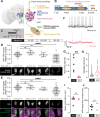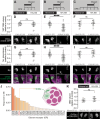Glia control experience-dependent plasticity in an olfactory critical period
- PMID: 39883485
- PMCID: PMC11781797
- DOI: 10.7554/eLife.100989
Glia control experience-dependent plasticity in an olfactory critical period
Abstract
Sensory experience during developmental critical periods has lifelong consequences for circuit function and behavior, but the molecular and cellular mechanisms through which experience causes these changes are not well understood. The Drosophila antennal lobe houses synapses between olfactory sensory neurons (OSNs) and downstream projection neurons (PNs) in stereotyped glomeruli. Many glomeruli exhibit structural plasticity in response to early-life odor exposure, indicating a general sensitivity of the fly olfactory circuitry to early sensory experience. We recently found that glia shape antennal lobe development in young adults, leading us to ask if glia also drive experience-dependent plasticity during this period. Here, we define a critical period for structural and functional plasticity of OSN-PN synapses in the ethyl butyrate (EB)-sensitive glomerulus VM7. EB exposure for the first 2 days post-eclosion drives large-scale reductions in glomerular volume, presynapse number, and post- synaptic activity. Crucially, pruning during the critical period has long-term consequences for circuit function since both OSN-PN synapse number and spontaneous activity of PNs remain persistently decreased following early-life odor exposure. The highly conserved engulfment receptor Draper is required for this critical period plasticity as ensheathing glia upregulate Draper, invade the VM7 glomerulus, and phagocytose OSN presynaptic terminals in response to critical-period EB exposure. Loss of Draper fully suppresses the morphological and physiological consequences of critical period odor exposure, arguing that phagocytic glia engulf intact synaptic terminals. These data demonstrate experience-dependent pruning of synapses and argue that Drosophila olfactory circuitry is a powerful model for defining the function of glia in critical period plasticity.
Keywords: D. melanogaster; Draper; MEGF10; critical period; neuron-glia interactions; neuroscience; synapse pruning.
© 2024, Leier, Foden et al.
Conflict of interest statement
HL, AF, DJ, AW, PV, PV, JC, MT, HB No competing interests declared
Figures








Update of
-
Glia control experience-dependent plasticity in an olfactory critical period.bioRxiv [Preprint]. 2024 Oct 24:2024.07.05.602232. doi: 10.1101/2024.07.05.602232. bioRxiv. 2024. Update in: Elife. 2025 Jan 30;13:RP100989. doi: 10.7554/eLife.100989. PMID: 39005309 Free PMC article. Updated. Preprint.
Similar articles
-
Neuron-to-glia signaling drives critical period experience-dependent synapse pruning.Sci Rep. 2025 Jul 16;15(1):25744. doi: 10.1038/s41598-025-11528-3. Sci Rep. 2025. PMID: 40670566 Free PMC article.
-
Selective life-long suppression of an odor processing channel in response to critical period experience.bioRxiv [Preprint]. 2025 Jul 20:2025.07.18.665601. doi: 10.1101/2025.07.18.665601. bioRxiv. 2025. PMID: 40791412 Free PMC article. Preprint.
-
Glia control experience-dependent plasticity in an olfactory critical period.bioRxiv [Preprint]. 2024 Oct 24:2024.07.05.602232. doi: 10.1101/2024.07.05.602232. bioRxiv. 2024. Update in: Elife. 2025 Jan 30;13:RP100989. doi: 10.7554/eLife.100989. PMID: 39005309 Free PMC article. Updated. Preprint.
-
Signs and symptoms to determine if a patient presenting in primary care or hospital outpatient settings has COVID-19.Cochrane Database Syst Rev. 2022 May 20;5(5):CD013665. doi: 10.1002/14651858.CD013665.pub3. Cochrane Database Syst Rev. 2022. PMID: 35593186 Free PMC article.
-
The Black Book of Psychotropic Dosing and Monitoring.Psychopharmacol Bull. 2024 Jul 8;54(3):8-59. Psychopharmacol Bull. 2024. PMID: 38993656 Free PMC article. Review.
Cited by
-
Neuron-to-glia signaling drives critical period experience-dependent synapse pruning.Sci Rep. 2025 Jul 16;15(1):25744. doi: 10.1038/s41598-025-11528-3. Sci Rep. 2025. PMID: 40670566 Free PMC article.
-
Selective life-long suppression of an odor processing channel in response to critical period experience.bioRxiv [Preprint]. 2025 Jul 20:2025.07.18.665601. doi: 10.1101/2025.07.18.665601. bioRxiv. 2025. PMID: 40791412 Free PMC article. Preprint.
References
MeSH terms
Substances
Grants and funding
LinkOut - more resources
Full Text Sources
Molecular Biology Databases

